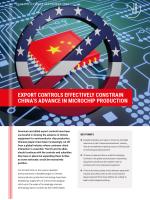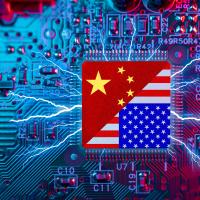Export controls effectively constrain China's advance in microchip production

- Despite loopholes and leaks in American and allied sanctions on the Chinese semiconductor industry, they are nonetheless imposing costs on China’s path to technological advancement.
- Chinese companies have a small but enlarging foothold in the global semiconductor chipmaking equipment market but are nowhere close to producing the most advanced equipment.
- China is throwing money at the domestic equipment industry but without links to the critical industry players beyond China these efforts are unlikely to lead to technological catch-up.
For the last three or four years, repeated announcements of breakthroughs in Chinese semiconductor production technology have been heralded by supporters of China’s technological catch-up in the wake of increasingly onerous technology export controls by the United States and decried by those worried about China’s rise. Yet these announced breakthroughs have thus far yielded more chimerical than commercial results. Consider a few examples: Huawei’s fab (fabrication) with Shanghai Micro Electronics Equipment (SMEE)? Never built. The not-Huawei-but-really-Huawei fab in Dongguan? Still a shell. SMEE’s vaunted lithography equipment? Has yet to make it from the lab to the fab.
And now things are going to get more difficult for China’s nascent semiconductor capital equipment sector as the previously unilateral American sanctions have been honed and become multilateral with the cooperation of the only two makers of significant semiconductor capital equipment, Japan and the Netherlands, this spring. The point isn’t that the sanctions are an entirely well-oiled machine without loopholes and leaks. Rather, the sanctions have been effective at imposing costs on China’s path to technological advancement. The controls on semiconductor production equipment have become, rightly or wrongly, especially effective as loopholes have been closed. And smuggling of equipment won’t be the answer due to regular servicing needs and
the small numbers of equipment ultimately produced and shipped.
The goal of American controls is to increase the cost of China’s advanced chipmaking, not prevent it entirely.
This brief first dispels the myth of China’s technological leapfrogging in fabrication equipment. Contra to this belief, China remains dependent on foreign equipment for efficient, mass production of chips. It then assesses the state of play within China’s semiconductor equipment sector for chipmaking. It finds that China’s equipment remains concentrated in non-critical, trailing edge processes. This finding begs the question about future development. It argues that certain features of the semiconductor equipment space make it very unlikely that China (or any other country) could create all the equipment it needs for efficient, mass production at home. In conclusion, the brief points out that China’s key leverage in this space, its large consumption of capital equipment, is actually in decline.
It is important to reiterate that the standard is not whether China could produce chips at home in a very inefficient manner with solely domestic equipment. China could do so but the goal of American controls is to increase the cost of China’s advanced chipmaking, not prevent it entirely. The implicit assumption of the American government’s stated intention to prevent China from being even a fast follower in chipmaking tech is that a fast follower would be producing chips efficiently at scale several generations behind the
tech frontier.
The Myth of China’s Technological Leapfrogging in Chipmaking Equipment
In chipmaking lithography width is paramount – and the smaller the better. While there are claims that China created 14 nanometer (nm) and 7 nm chipmaking lines without American equipment, there is no evidence that this is the case for at scale, efficient production lines (the smallest chip yet developed is IBM´s 2 nm microchip). First, until the October 7, 2022 American controls were put in place, China’s Semiconductor Manufacturing International Corporation (SMIC), the purported champion of this leapfrogging, could and did actually use equipment from American companies even for controlled below-10nm process tech as long as that equipment was not produced in the US. Industry interlocutors told this author that SMIC was using such American equipment from Southeast Asia. The US Person controls under the new rules prevent American companies from selling any controlled equipment to SMIC from anywhere. This eliminates this possibility for Chinese firms. Second, every industry expert I talked to in China believes the 7nm process SMIC reportedly used for one chip was simply older deep ultraviolet (DUV) lithography equipment running multiple exposures. Such a process has very low yields i.e., is extremely inefficient.
The situation today is very different than pre-October 7. SMIC, which has even withdrawn 14nm from the list of processes it offers from its website, cannot get extreme ultraviolet (EUV) lithography – the most advanced lithography – nor advanced DUV nor 11 different types of American equipment for which there is no current substitute, nor probably many different types of Japanese equipment for which a license is now required. Nor can SMIC get its equipment serviced for more advanced (16/14nm and below) processes. Typically, such equipment needs to be serviced frequently – at least every six months. It does not matter that China can make many kinds of noncritical fabrication equipment (see below) if it still has no access to many types of critical equipment necessary to be efficient at scale near or at the cutting edge of process technology.
State of Play in Equipment in China
Once the US government began weaponizing integrated circuit (IC) supply chains to target Huawei in 2019, China finally began to take indigenization of the wider IC supply chain more seriously. Whereas the first tranche of the so-called Big Fund state support plan spent most of its resources directly on fabrication (chipmaking) capacity, the second tranche of the Big Fund began to distribute significant resources to the capital equipment to produce chips.
Unfortunately, money alone will not solve China’s inability to access advanced equipment given its isolation from global tech partners.
The three most critical steps in fabrication of chips are deposition (placing materials on silicon wafers), lithography (using light to pattern circuits on wafers) and etching (removal of excess materials from wafers). Finally, there is critical process control equipment used across the chipmaking process to inspect and measure equipment performance.
Overall, Chinese companies still have a small foothold in the global equipment market at less than 3% of the global market in 2021 though Chinese firms have gained market share in mature nodes (28 nm and above) quite quickly since the advent of American sanctions. China is not anywhere close to producing the four types of critical equipment for chipmaking mentioned above, especially at more advanced production nodes according to a recent UBS report. Only in some very technological mature areas of deposition equipment are Chinese producers making critical equipment.
Generally, it seems that the government’s policies have not succeeded in incentivizing fabs operating in China to opt for Chinese suppliers. Seventy percent of respondents of a recent UBS survey found local equipment worse (much worse and slightly worse) in the key areas of stability, preciseness, and reliability. As a consequence, while 97 percent of the respondents expect Chinese equipment to achieve a market breakthrough in non-critical equipment, only three percent expected such a breakthrough in critical equipment within the next three years.
The Obstacles to Catching Up in Chipmaking Equipment
There have been incidents, where cutting off countries from access to certain sectors has led to the creation of competitive rivals from the very industries and countries targeted. China’s satellite industry arose in the wake of American controls on sales of American satellite technology to China. But the satellite industry had two features that aided China and are lacking in the chipmaking equipment industry: 1. there were other sources of satellite technology willing to work with China and 2. the vertically integrated nature of the value chain was well suited to China’s state-owned, mission-oriented industrial practice.
In the chipmaking equipment industry, the sources of potential technology are highly concentrated in just three countries (Japan, the Netherlands, and the US). All have agreed to control the export of that technology to China. Moreover, the leading vendors of chipmaking equipment have developed their capabilities over decades. To the extent they have lost their dominance in various chipmaking segments to other firms, those firms have also been industry incumbents. Both these facts suggest that it will be an uphill battle for Chinese firms to make serious gains in catching up to the technological frontier.
While 97 percent of respondents in a recent survey expect Chinese equipment to achieve a market breakthrough in non-critical equipment, only three percent expected such a breakthrough in critical equipment within the next three years.
The chipmaking equipment business has also been one where the capital equipment suppliers have worked closely with their customers, the chipmakers, especially the leading ones. Instead of an industry suitable for top-down state directives, this industry demands networking with other major industry players. Sadly for China, its entrants are not well connected to the major advanced chipmakers outside of China due to their small size and technological backwardness. They will likely never achieve those connections as long as geopolitical tensions remain high. This lack of strong working relationships with the likes of Samsung, TSMC, and Intel, make it hard for Chinese equipment makers to advance. As Mark Li of Bernstein Research put it: “This prevents whatever advances they make in R&D from getting into mass production, and also limits them from learning more tricks of the trade”.
China’s Less and Less Special Market
China’s equipment makers are trapped in a Galapagos market cut off from global tech by foreign controls, and that market is in relative decline. China has been a very large market for semiconductor equipment, peaking at 22-25 percent of the world market in 2022, but its share is projected to be just 20 percent in 2023. While globally capital expenditures are being cut back by 22.5 percent in 2023, in China they will fall by approximately one third. This shrinkage is not simply due to export controls. Renewed industrial policy and concomitant subsidies have resulted in many new investments planned in established semiconductor producers such as Japan, the EU, and the US. Korea and Taiwan have doubled down on subsidies too.
China’s strategy of throwing money at the domestic equipment industry without links to the critical industry players beyond China is unlikely to lead to technological catch-up. The potential huge increase in domestic investment in mature nodes, such as 28nm, in China also won’t help much with honing the equipment makers’ capabilities for more advanced nodes.
The US and its allies should continue with the controls and subsidies they have in place. They should not expand controls to mature nodes as some advocate. Broader controls constitute excessively punitive mission creep. Even without such radical measures, China still won’t catch up.



